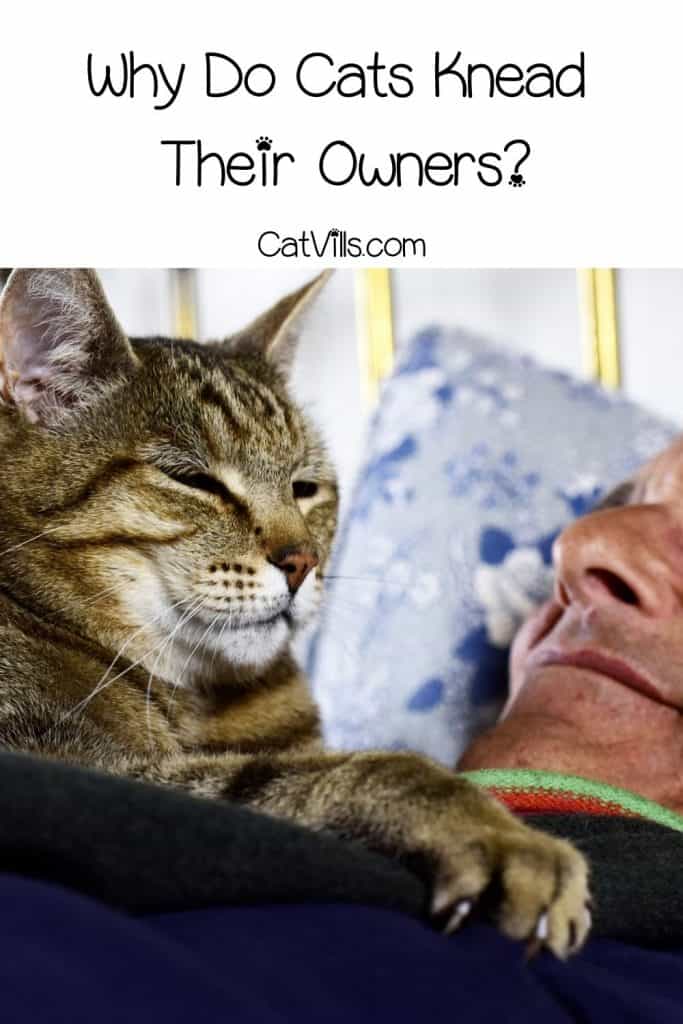Last Updated: 1 year ago
Why do cats knead? And do they all do it?
Cats have some pretty funny ways of showing their human affection.
If a human headbutts you, you’ve clearly upset them; if your cat headbutts you, it must be love!
Keep reading to discover why your cat kneads you and where this instinctive behavior comes from.
Why Do Cats Knead?

Making cookies, making bread, making biscuits, milk treading, happy paws, and kitty jazz hands are just some of the terms I found people using to describe the kneading behavior often performed by cats.
I’m sure you know what I mean, but just in case, kneading is the motion your cat makes with her paws as she kneads them in and out of a soft object, you, a blanket, or even the air repeatedly.
Some cats spread their toes or extend their sharp claws with each motion too. Nobody knows for sure why cats perform this common behavior, but there are some popular theories.
1. It’s A Comforting Reminder of Kittenhood
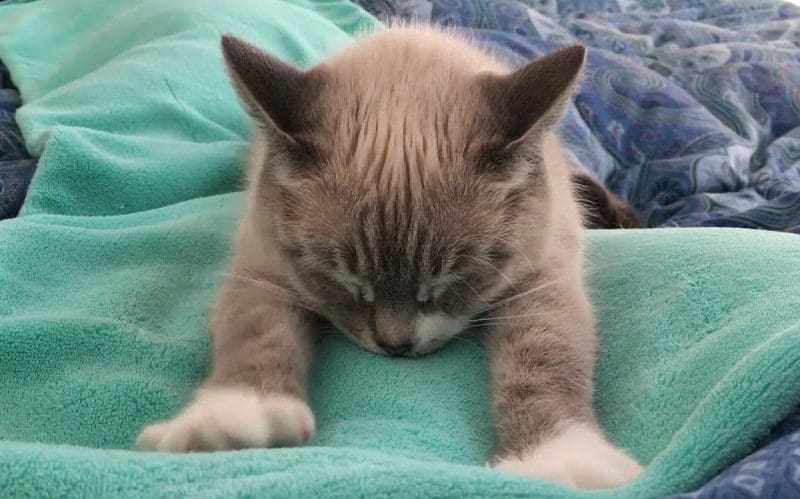
Kittens instinctively knead their mothers to stimulate milk production. But why do they carry this on into adulthood?
Is your adult cat really trying to milk the sofa?
One theory is that cats continue kneading into adulthood as they associate the act with the comfort, security, and warm fuzzy feelings they felt when nursing.
This is probably the most popular explanation for cat-kneading behavior.
There is further evidence to indicate it could be correct; some cats try to suckle the object they are kneading.
2. To Stake Their Claim
As soon as your cat finds a soft surface where they enjoy kneading and biting, they will want to have it all to themselves.
Once the cat has begun to claim it as its own territory, it will release its scent onto the soft surface.
This is because cats can sweat from the soft pads found at the very bottom of their paws. If you have a single cat in your home, you may not see this behavior so much or at all.
Because it is territorial, a cat may not see the need to claim a soft surface as their own, as they already lay claim to it constantly.
However, in a multi-cat household, you may see one cat seemingly pick a soft surface like a blanket and continue to knead and bite it.
With more sweat, they can steer other cats away, claim the surface as their own, and use it as a preferred sleeping spot.
3. To Make A Cozy Bed
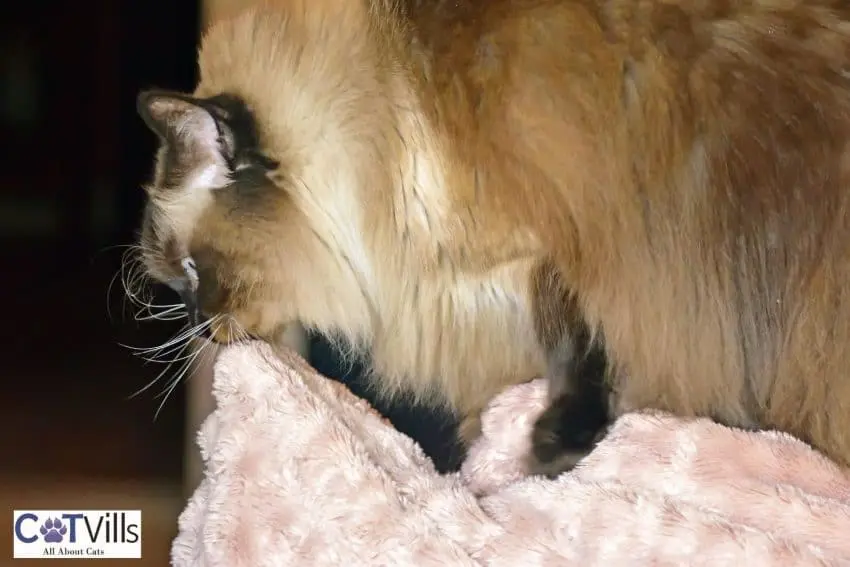
The kneading may even be a way for a cat to get in touch with their ancestors.
A theory goes that the first generations that became domestic cats would use kneading to make their bed or create a birthing site by softening those long grasses of the African Savannah that they called home.
By making their bed, they could be thinking of going to sleep, which would explain why so many cats get sleepy while they knead.
However, if the cat continues to knead in a single place, it could be that the behavior is more play than bed-making.
Could your cat’s kneading be an instinct carried over from all those years ago?
4. To Show You Love
All of the theories above point to one thing. Your cat is happy, comfortable, and showing you affection by kneading you.
Perhaps she feels the same comfort and security with you as she did with her mother. You make her feel all warm and fuzzy, just like she did when she was little.
Or maybe she wants to cover you with the scent of her paws to let the world know that you’re her favorite person.
Perhaps she’s poking and prodding you to make sure your lap is just right for a catnap. Your cat sleeping on you is a sure sign they love and trust you.
5. To Play

The first common reason is simply that cats view the act of kneading as something enjoyable and a version of play.
Kneading and then biting a blanket may look quite similar to another typical feline behavior, which is when they use their hunting instincts.
This may be an object, such as a favorite plaything that may be on the blanket, or simply the blanket itself, that can be grabbed with their forelimbs and then bitten.
If you do not want them to be biting your blanket or sweater, then ensure that they are actively stimulated during their waking hours with lots of cat toys.
6. Indications Of Trust
A cat kneading on a soft surface that happens to be on your lap should be a good sign of trust.
This is largely due to the same behavior being exhibited when kittens knead on their mothers during the nursing phase.
This same behavior is carried on into adulthood, which means they may knead you instead as their owner.
The kneading may occur closer to their bedtime because, if they trust you as their owner, it can be quite soothing to knead a soft surface.
There may be some drooling, which is an even better sign, as cats tend to feel vulnerable just before they fall asleep.
If they felt that they trusted their mothers to keep them safe, then the same kneading should indicate that they trust you to keep them safe too.
While the cat may certainly be enjoying the feel of the soft surface on your lap, you should enjoy this as a sign of affection.
Certainly, this behavior should show you that they feel exceedingly comfortable and loved. Feel free to give them a stroke while they are kneading.
The kneading may actually be a comforting act that the cat uses as anxiety relief. If your cat seems particularly distressed, then try to pet them gently while they are kneading.
Perhaps you see this as a time to show your cat some appreciation, so spoil them with a few treats.
The kneading may even be a sign that the cat is being bullied and trusts you to look after them while they are enjoying the kneading.
Is Cat Kneading Normal?
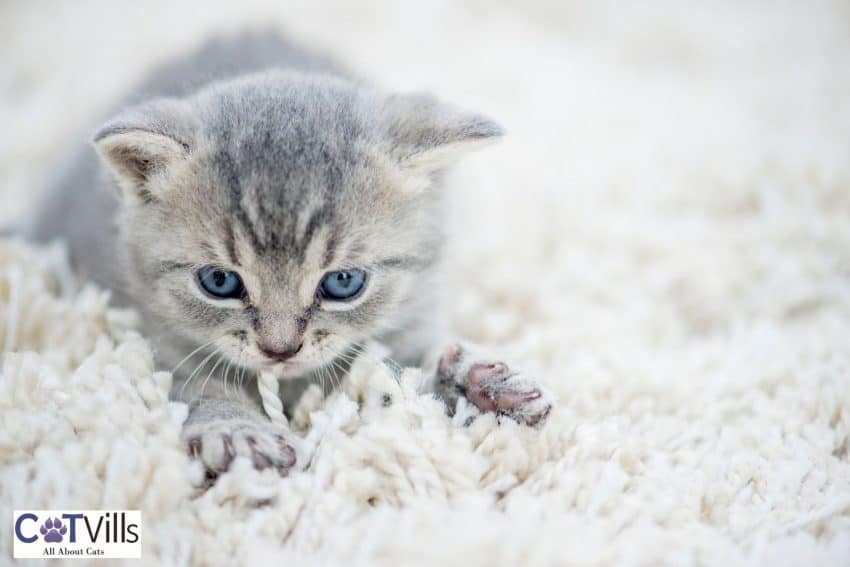
For all the reasons we explored above, kneading is a perfectly normal feline behavior. Not all cats make biscuits, which isn’t a cause for concern either.
Cats all have their own personalities, and some are more inclined toward instinctive behaviors than others.
How To Stop Your Cat Kneading if it’s Hurting You
While you should feel honored that your cat trusts and adores you enough to knead you, it can be easier said than done if they add their claws to the equation.
So how do you maintain the bond with your cat while avoiding the pain and claw marks during such moments?
1. Don’t Punish Your Cat
Before we move on to any other solutions, it’s important to note that you should not punish your cat for habits that come naturally to her.
She won’t understand your reaction to her behavior and could lash out at you in retaliation for your unexpected response.
I appreciate that it’s hard to stay calm with claws in your thigh, but using some of the following techniques will help you deal with the situation appropriately.
2. Put A Blanket On Your Lap

Keep a thick, soft blanket or towel nearby and place it on your lap before your cat climbs on it.
This has the benefit of allowing you to enjoy your cat’s affection without the pain of her claws digging into your flesh.
3. Trim Your Cat’s Claws
Keeping on top of trimming your cat’s claws may be enough to stop kneading, a painful experience.
If the claws don’t end in sharp points, they will be less likely to scratch or puncture your skin.
If your legs are bare or only covered by thin material, it could be an uncomfortable experience.
But blunt claws are unlikely to bother you much through denim, for example.
4. Divert Your Cat’s Attention
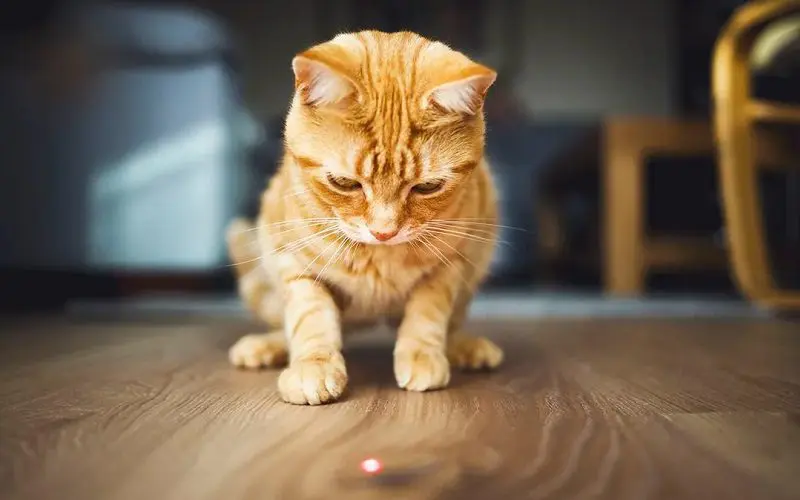
If you want to stop the kneading behavior altogether, the best way is to divert your cat’s attention elsewhere.
Engage your cat with a toy she likes or shine a light for her to chase around the room.
Some owners even train their cats to perform other behaviors.
5. Negative Association Scents
Indeed, a smell is important to a cat, so if you have a particularly valuable blanket or sweater, you can dissuade your cat from kneading it.
Try a spray that veterinarians use to discourage a cat from biting, licking, and chewing their bandages.
As soon as they get the smell, they should stay away and find something else to knead.
FAQs
Do cats only knead people?
No, cats knead other cats, other animals, soft objects, people, and the air. One of my cats even kneads the dog!
Cats knead when they feel comfortable, to spread their scent, and to prepare a cozy spot for sleeping.
Does every cat knead?
Kneading is a typical, perfectly normal cat behavior, but not every cat does it.
You have nothing to worry about if your cat does or doesn’t knead; it’s just part of what makes them a unique feline individual.
WHY IS MY CAT KNEADING AND THEN BITING ME?
If your male cat is aggressively kneading while sitting on your lap, then this behavior typically needs to be left alone.
Your cat may seem to be overly excited while they are doing the kneading, and in this heightened state, you may experience some biting and scratching.
It is best to leave them to enjoy their kneading, even if it does seem a little painful.
Final Thoughts
Nobody really knows for sure why our feline friends perform this adorable behavior.
Still, the most common theory is that it carries over from an instinctive nursing behavior seen in kittens.
All of the theories agree that if your cat is kneading you, it’s a sign of affection, trust, and happiness.
If kneading is a painful experience for you, don’t punish your kitty for doing what comes naturally.
Instead, place something over your legs to stop your cat’s claws from hurting you, or do something to divert your cat’s attention elsewhere.
Thanks for reading, cat lovers! Why do cats knead? Share your cat-kneading experiences below!
